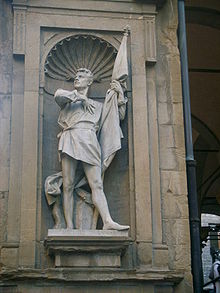Loggia del Mercato Nuovo

The Loggia del Mercato Nuovo (Italian pronunciation:
History

The loggia was built around the middle of the 16th century in the heart of the city, just a few steps from the Ponte Vecchio. Initially, it was intended for the sale of silk and luxury goods and then for the famous straw hats,[1] but today mainly leather goods and souvenirs are sold.
In the corner niches statues of famous Florentines were intended to be placed, but only three were made at the end of the 19th century: Michele di Lando by Ippazio Antonio Bortone, Giovanni Villani by Gaetano Trentanove, and Bernardo Cennini by Emilio Mancini.[2]
The focal point of the loggia is the Fontana del Porcellino (IPA:
Pietra dello scandalo
Another oddity of the place is the so-called pietra dello scandalo (IPA: [ˈpjɛːtra dello ˈskandalo]; "stone of shame"), a round spot marked in bicoloured marble at the centre of the loggia, which is only visible when no sales stalls are there. The design reproduces one of the wheels of a medieval Carroccio, symbol of the Florentine republic, on which the city's standard was hoisted daily.[4] The Carroccio was placed on this spot and Florentine troops met around it before every battle.[5]
The spot was later chosen for another purpose, whence its alternative name pietra dell'acculata (IPA: [ˈpjɛːtra dellakkuˈlaːta]; approximately "stone of the bum punishment"). During the Renaissance, the punishment of insolvent debtors included being chained to a post on this spot and then paddled repeatedly on the naked buttocks. The popular expression stare col culo a terra ("to have one's ass on the ground") and the word sculo (a dialectal word for "misfortune") may have originated from this practice.[6]
Other images
-
The bronze of the Porcellino.
-
The pietra dello scandalo.
-
Night view, without sales stalls.
See also
- Arcade (architecture)
- Mercato Centrale (Firenze)
- Marketplace
- Merchant
- Retail
Sources
- ISBN 978-88-09-03398-6.
- ^ Levey, M. (1996). Florence: A Portrait. Jonathan Cape Ltd, page 103.
- ^ Masseti, Marco (2008). Sculptures of mammals in the Grotta degli Animali of the Villa Medici di Castello, Florence, Italy: a stone menagerie. Archives of Natural History, 35:1, pages 100-104.
- ^ Mangone, Fabio (1994). La pietra dello scandalo. Uso e disuso della pietra nell'architettura moderna. Tema, n. 2.
- ISBN 978-88-7989-921-5.
- ^ Giusti G. (1903). Raccolta di proverbi toscani, Ed. Successori Le Monnier.




